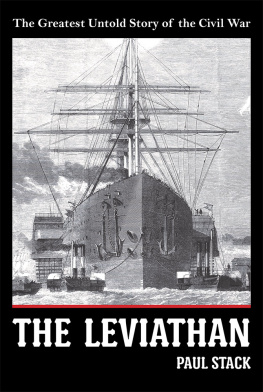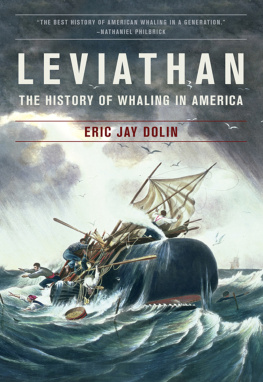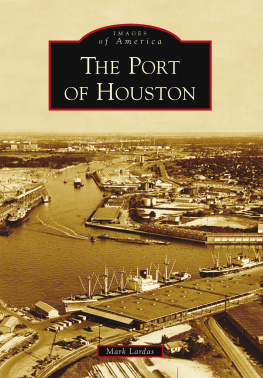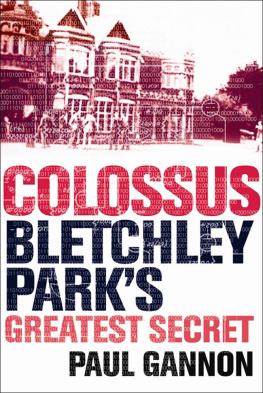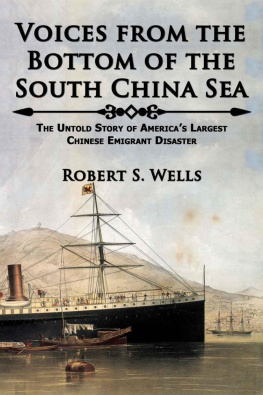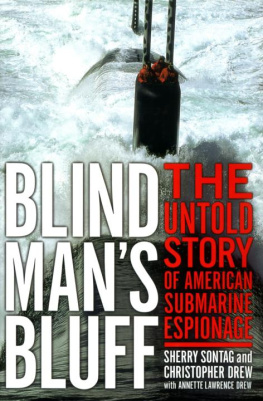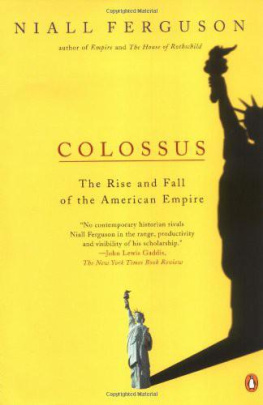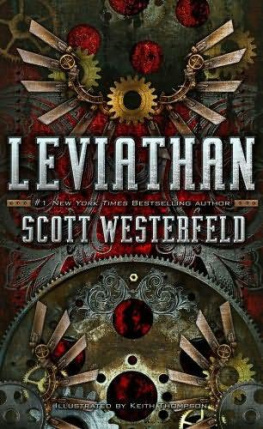The Leviathan
The Greatest Untold Story of the Civil War
PAUL STACK

Copyright 2019 Paul Stack.
All rights reserved. No part of this book may be used or reproduced by any means, graphic, electronic, or mechanical, including photocopying, recording, taping or by any information storage retrieval system without the written permission of the author except in the case of brief quotations embodied in critical articles and reviews.
Certain characters in this work are historical figures, and certain events portrayed did take place. However, this is a work of fiction. All of the other characters, names, and events as well as all places, incidents, organizations, and dialogue in this novel are either the products of the authors imagination or are used fictitiously.
Archway Publishing
1663 Liberty Drive
Bloomington, IN 47403
www.archwaypublishing.com
1 (888) 242-5904
Because of the dynamic nature of the Internet, any web addresses or links contained in this book may have changed since publication and may no longer be valid. The views expressed in this work are solely those of the author and do not necessarily reflect the views of the publisher, and the publisher hereby disclaims any responsibility for them.
Any people depicted in stock imagery provided by Getty Images are models, and such images are being used for illustrative purposes only.
Certain stock imagery Getty Images.
Scripture taken from the King James Version of the Bible.
Scripture taken from the American Standard Version of the Bible.
ISBN: 978-1-4808-7388-9 (sc)
ISBN: 978-1-4808-7390-2 (hc)
ISBN: 978-1-4808-7389-6 (e)
Library of Congress Control Number: 2019900799
Archway Publishing rev. date: 04/05/2019
Contents
To librarians, past and present, for without their contribution to knowledge this book could not have been written
As will be explained shortly, my interest in the Great Eastern began when Nea, my wife, purchased a used book. During the years I researched and wrote this book, she was my constant cheerleader and proofreader. My daughters Nea Elizabeth and Sera always gave me encouragement, and Sera helped me with the books graphics.
My friend Barbara Purdy helped me understand the use of dialogue to tell a story. She also suggested the creation of a character who filled a void in my narrative. Barbaras son, Bill, is a natural storyteller with insight into human motivation. I used him repeatedly to check the authenticity of my fictional characters actions.
My friend Gabrielle Kelly helped me get started on this book, the hardest thing for any author. Hannah Cunliffe, my English researcher, skillfully dug out documents from British sources, many of which had been unseen for over a century. Elizabeth Barbour translated copies of correspondence from almost unreadable handwriting into written text. Many of the source documents that I have posted at www.september1861.com are a result of Hannahs and Elizabeths work.
As the book neared completion, I sought and received comments and criticisms from friends whose opinions I respected. These friends, in alphabetical order, included Tim Fraser, Alexander Kerr, Ira Mirochnick, William OConnor, Thomas Rickner, and Cheryl Zeigler. Finally, I want to thank Bayo Ojikutu and David Aretha, two experienced Chicago authors, for their reviews and comments.
Leviathan A sea monster mentioned in the book of Job, where it is associated with the forces of chaos and evil.
The New Dictionary of Cultural Literacy (2002)
IN 1999, my wife and I attended the opening of a new reading room in our villages library. While I was taking a tour, my wife, a school librarian, rummaged through the librarys discarded-book bin. As we were leaving, she handed me a book she had bought for a quarter The Great Iron Ship , first published in 1953.
The book was a quick and enjoyable read. James Dugan, the author, was more a raconteur than a historian, but there were enough of both elements to provide a lively retelling of an amazing ship. On finishing the book, I wanted to learn more about the ship, initially christened Leviathan but later known as the Great Eastern , so, using the internet, I began to locate other books and collectibles relating to her. Through internet auctions, I acquired old issues of the Illustrated London News and Harpers Weekly , located two other books and various periodicals, and even purchased an original Currier and Ives print of the ship for my library. In August 2001, however, I ran across an object that gave me pause.
A dealer in Australia was offering for sale a carved trochus shell. The seashell was a cone comprised of ring like layers. The carving on the lowest and largest ring read The Great Eastern Steam Ship and contained a detailed profile of the ship along with the words 24500 Tons. The next higher ring had a carving of what appeared to be a gate next to a large tree. The scene was engraved Tomb of A Lincoln Presidt. of U.S. An examination of photographs and prints of Lincolns tomb in Springfield, Illinois, led me to the conclusion that the carved tomb was a somewhat inaccurate representation of an early tomb in Springfield, one in which Lincoln was interred from his death in 1865 until 1871.
The shell was puzzling. Why would a person have an image of a ship launched in London carved on one part and then have a likeness of the Midwestern tomb of a US president carved on another? I could think of no connection between these objects. The Great Eastern was launched on the River Thames in January 1858, and Lincoln was interred in the spring of 1865. A quick review of different biographies of Lincoln disclosed no reference to the Great Eastern , and nothing in the books on the Great Eastern I had acquired made any reference to Lincoln. Yet both ship and tomb were on the shell. Curious, I placed a large enough bid on the shell to ensure that, barring the appearance of some fanatical collector, it was mine. I was successful. Shortly after I mailed my check to Australia, the events of September 11, 2001, occurred. The shell and many other things were forgotten in the aftermath of that shocking event. In early October, however, a package arrived at my office. It was the shell.
The shell was more beautiful than I had anticipated. It had been polished so that it had a luster similar to mother-of-pearl. The detailed carvings of the ship and tomb showed considerable artistic skill, as did the accompanying cursive lettering. Looking closely, I saw something not mentioned in the internet listing. Above the carving of the tomb, toward the top of the cone, was a faintly carved symboltwo crossed objects that could have been feathers, quills, or wings. No writing accompanied this symbol. The dealer in Australia, responding to my email, could provide no information about the shell, other than to relate secondhand information that it had been brought to Australia from England many years ago by an unidentified gentleman.
One fall evening, while sitting in my library, I studied the shell closely under a magnifying glass. I could find no further carvings, but a thought occurred to me. Had someone used the shell to record an event? I decided to find out.

I believed that if the shell indeed depicted a true event, the event most likely occurred during the Civil War. Accordingly, I began my initial research by searching a vast collection of documents written during the war. As early as 1866, the federal government began the mammoth task of collecting and typesetting as many Civil War documents as it could locate from both the Union and Confederate sides. The ultimate product, entitled The Official Records of the War of the Rebellion: A Compilation of the Official Records of the Union and Confederate Armies, consists of nearly 140,000 pages assembled in 128 volumes. Although the sheer size of the collection was daunting, I learned that it had been digitized and that a website offered by Cornell University allowed the public to freely view and search it. There were only a few entries for Great Eastern, but one caught my attention. On September 9, 1861, Charles Francis Adams, the American envoy to Great Britain, wrote a letter to William Henry Seward, the US secretary of state. After summarizing communications he had had with the British government, Adams wrote,
Next page
